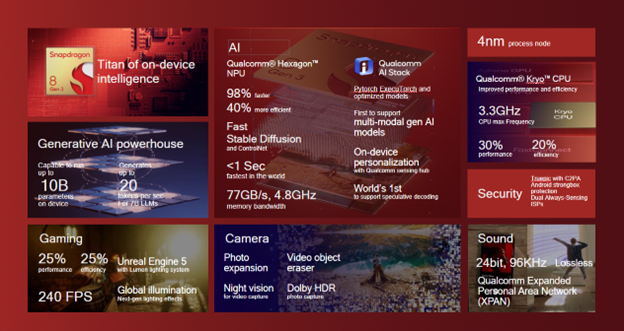What is Qualcomm’s Snapdragon 8 Gen 3? All about the new mobile platform
Meet the Snapdragon 8 Gen 3, Qualcomm’s latest and greatest mobile chip. It can do incredible AI tasks like expanding photos, generating backgrounds, and removing objects from videos.
 The Snapdragon 8 Gen 3 is 30% faster than the previous generation. (Image: Qualcomm)
The Snapdragon 8 Gen 3 is 30% faster than the previous generation. (Image: Qualcomm) Qualcomm has just unveiled its latest and greatest mobile chip, the Snapdragon 8 Gen 3. It can handle some impressive AI tasks on the fly, like expanding photos, generating backgrounds, and even removing objects from videos.
The chip also boasts a speed boost for running AI models like Stable Diffusion and Meta’s Llama 2, thanks to an upgraded Hexagon neural processor that’s 98 percent faster than before. Qualcomm demoed the Snapdragon 8 Gen 2’s ability to run Stable Diffusion back in February, but the company is doubling down on AI performance with the Gen 3, given how much AI tech has advanced this year.
The Snapdragon 8 Gen 3 is also a powerhouse for gaming, with support for global illumination with ray tracing and Unreal Engine 5 with lumen. The chip can handle gaming at a staggering 240 FPS on 240Hz displays, even as these are yet to be seen on any smartphone. And of course, the Adreno GPU under the hood has been improved by 25% in both speed and efficiency.
But that’s not all. The Snapdragon 8 Gen 3 comes with the usual upgrades you’d expect from a new generation of this chip family. The chip is overall 30% faster than the previous iteration – the Snapdragon 8 Gen 2 – and supports features like night vision video capture, Dolby HDR photo capture, and 5G Advanced.
The 30% leap is especially impressive considering that the previous iteration was ‘only’ around 15% faster than its predecessor.
 (Image: Qualcomm)
(Image: Qualcomm)
The only downside is that the Snapdragon 8 Gen 3 still uses the same 4nm fabrication process as the Snapdragon 8 Gen 1. The iPhone 15 Pro Max has pulled ahead this year with its Apple A17 Pro chip, which is the first and only smartphone chip to use a 3 nm process.
In processors, “nm” stands for nanometer, which is one billionth of a meter. A smaller number means that more transistors can be packed in the same area, resulting in more efficient and faster processors. But despite this drawback, Qualcomm claims that the Snapdragon 8 Gen 3 is 20% more efficient, so there’s that.
The first phone to sport this chip will likely be the Xiaomi 14 series or Samsung’s Galaxy S24 line, which is expected to launch in early 2024. As Qualcomm’s flagship mobile chip, it’ll also power other high-end Android phones throughout the year, except for Google’s Pixel line, which uses its own Tensor processors.
According to Qualcomm, these high-end Android phones include offerings from Asus, Honor, iQOO, Meizu, Nio, Nubia, OnePlus, Oppo, realme, Redmi, RedMagic, Sony, Vivo, Xiaomi, and ZTE – basically, most of the Android’s premium smartphone ecosystem.
“Snapdragon 8 Gen 3 infuses high-performance AI across the entire system to deliver premium-level performance and extraordinary experiences to consumers. This platform unlocks a new era of generative AI enabling users to generate unique content, help with productivity, and other breakthrough use cases.” said Chris Patrick, senior vice president and general manager of mobile handsets at Qualcomm.
Qualcomm’s Snapdragon 8 series has been long regarded as the benchmark for Android processing performance, backed by extensive support and optimisation by third-party apps and games. But while these chips truly offered the best in the world of Android, the competition is fast heating up with offerings from MediaTek, Samsung, and Google catching up – and as is the case with MediaTek, even pulling ahead in some cases.







